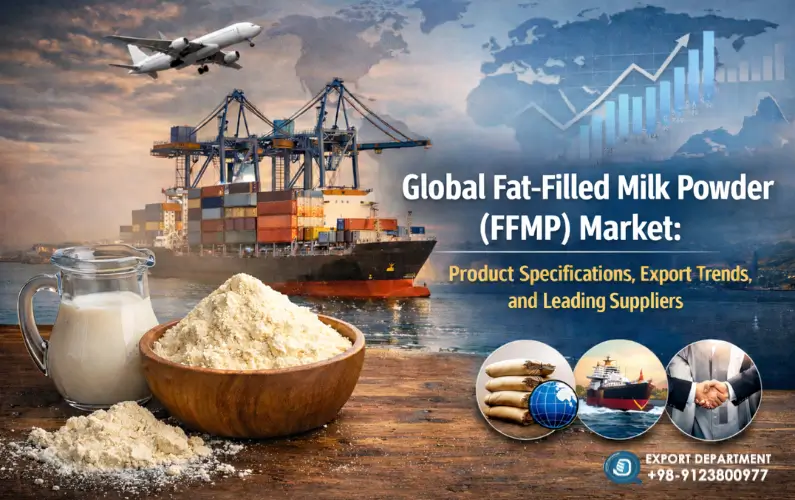Everything about the Production, Export, and Purchase of Exported Milk Powder from Iran
In this article, we will discuss the steps involved in preparing milk powder in factories, the best-known Iranian milk powder production brands, different categories, and export challenges in this industry.
| Table of Contents |
| 1. Composition of fresh cow's milk |
| 2. Steps in preparing milk powder in a dairy factory |
| 3. Acquaintance with Chaltafarm Export Products |
| 4. Major Manufacturers of Powdered Milk in Iran |
| 5. How Much Milk Powder Can You Get from Chaltafarm Milk? |
| 6. Fat Content Variations in Chaltafarm Milk Powder |
| 7. Protein Content of Chaltafarm Milk Powder |
| 8. Types of Chaltafarm Powdered Milk in Terms of Solubility |
| 9. Skimmed Milk Powder: Variations in Heat Treatment and Applications |
| 10. Chaltafarm UHT milk powder |
| 11. Understanding the Distinctions Between Nonfat Dry Milk and Skim Milk Powder |
| 12. Which countries has Chaltafarm milk powder been exported to? |
| 13. Chaltafarm milk powder, for export or domestic consumption? |
| 14. Top Buyers of Chaltafarm Milk Powder |
| 15. Export challenges in Iran milk powder industry |
| 16. Surge in Milk Powder Exports from Iran to Neighboring Countries |
| 17. Monthly Export of 600 Tons of Butter to Azerbaijan |
| 18. Chaltafarm Exports 2,500 Tons of Dairy Products Monthly |
| 19. Chaltafarm Exports 250 Tons of Milk Powder Monthly to Afghanistan |
| 20. Chaltafarm Exports 150 Tons of Milk Powder Monthly to Syria |
| 21. Monthly production of 1700 tons of industrial milk powder and 900 tons of butter |
Composition of fresh cow's milk
The main components of milk are water, fat, protein, lactose (milk sugar), and minerals. Milk also contains small amounts of other substances such as pigments, enzymes, vitamins, phospholipids (substances with fat-like properties), and gases. The amount of the main components of milk can vary significantly between cows of different breeds and between cows of the same breed. Therefore, only approximate values can be given. Cow's milk consists of about 87% water and 13% dry matter. The dry matter is suspended or dissolved in water. In addition to total solids, the term solids-not-fat (total solids minus fat) is used in milk composition discussions, the average content of which is 3.9 - 13.0 = 9.1%.
Steps in preparing milk powder in a dairy factory
Milk powder production is a simple process that can be carried out on a large scale. Milk powder production involves removing water at the lowest possible cost under hygienic conditions while preserving all the desirable natural properties of milk such as color, flavor, solubility, and nutritional value. The conventional milk powder production process starts with taking the raw milk received at the dairy factory and pasteurizing and separating it into skim milk and cream using a separator. The resulting skim milk is homogenized and standardized. For example, if whole milk powder is to be produced, a portion of the cream is added back to the skim milk to produce a milk with a standardized fat content (typically 26-30% fat in the powder). The standardized milk is then concentrated in an evaporator and spray dryer and milk powder is obtained. Excess cream is used to make butter or anhydrous milk fat. See the following video for the steps involved in preparing milk powder in a dairy factory.
Acquaintance with Chaltafarm Export Products
Chaltafarm offers a comprehensive selection of milk powder and other dairy derivatives, available for order and export:
- Export skimmed milk powder: This powder is produced from fresh skimmed cow's milk. It is available in low heat, medium heat, and high heat varieties.
- Export whole milk powder: Whole milk powder is one of Chaltafarm's industrial products and is obtained by drying fresh milk. It is available in instant and powdered varieties.
- Export buttermilk powder (bmp): Buttermilk is a byproduct of butter production. The protein composition of this product is the same as skimmed milk powder, although it has a slightly higher fat content. In addition, it is a good source of calcium, phosphorus, riboflavin, and vitamin B12. Chaltafarm buttermilk powder has many applications including use in evaporated milk, sweetened condensed milk, UHT sterilized milk, ice cream, chocolate, margarine, and baked goods.
- Export pasteurized butter salted/unsalted: Butter (SCB) with high fat content is made from fresh cream using butter making technology. It is sold in salted and unsalted varieties.
- Export pasteurized high-fat cream: Pasteurized high-fat cream is made from fresh milk using separator technology. It is sold in 40% and 50% fat varieties.
- Export evaporated milk: Pasteurized frozen evaporated milk is an alternative to fresh milk. It is sold in frozen skimmed evaporated milk and frozen whole evaporated milk varieties.
Major Manufacturers of Powdered Milk in Iran
If you're looking to buy bulk milk powder, Iran boasts several well-established producers. Here's a list of some of the most prominent brands:
- Chaltafarm
- Pegah (Iran Dairy Industries Company (IDIC))
- Montera
- Golshad
- Nestlé
- Kalle
- Kalber Dairy
- Khazra Dairy
- Pure Fresh
- bornalaban
- Arin Laban
- Zarin Shad
- Calin Dairy
- Ramak Dairy
These commercial brands have a significant presence in the Iranian market and produce dairy products, including well-known milk powder. However, it's always a good idea to check with retailers or online marketplaces to make sure specific brands are available in your area and consider consumer feedback and preferences when choosing the best brand for your needs.
How Much Milk Powder Can You Get from Chaltafarm Milk?
The amount of milk powder you can obtain from Chaltafarm fresh milk depends on whether you're looking for skimmed or whole milk powder:
- Skimmed Milk Powder: Around 10 to 11 kilograms of raw milk are typically needed to produce 1 kilogram of skimmed milk powder. In other words, you can expect to get roughly 150 grams of skimmed milk powder from each liter of fresh milk.
- Whole Milk Powder: For whole milk powder, approximately 8 kilograms of raw milk are required to produce 1 kilogram of powder.
Fat Content Variations in Chaltafarm Milk Powder
Choosing the right fat content for your milk powder needs is important. This information is usually provided on the product label or in the specifications. Make sure the fat content aligns with your standards and requirements.
Chaltafarm offers milk powder with varying fat content, which also affects the energy value:
- Whole Milk Powder (WPM): This type retains the natural fat content of fresh milk, containing 26-28% fat.
- Skimmed Milk Powder (SPM): This powder is produced by removing the fat content from fresh milk, resulting in a maximum fat content of 1.5%.
Protein Content of Chaltafarm Milk Powder
The protein content significantly impacts the nutritional value and overall quality of the final product. Protein plays a crucial role in creating a desirable taste and texture in food products, ultimately influencing their value and popularity. Therefore, checking the protein content of milk powder is essential.
Based on Chaltafarm's data, the average weight of non-fat dry matter in milk received at their factory over the past year is 8.49 ± 0.52%, and the average protein content is 3.07 ± 0.21%. Considering a moisture content of 3-5% in their finished milk powder, the minimum protein content in the non-fat dry matter of Chaltafarm's milk powder is at least 34%.
This high protein content makes Chaltafarm's industrial milk powder a versatile choice for various food applications. Chaltafarm industrial milk powder has high protein and therefore it is widely used in various food industries.
In the article "Yogurt Manufacturing Process and the Application of Milk Powder" you can discover the essential role of protein in achieving the desired texture of yogurt. Powdered milk is a source of protein in your yogurt production. In this article, learn why Chaltafarm milk powder with 36-34% protein is the ideal choice in dry month without fat.
Advantages of high protein for the food industry:
Improve product quality
Improve nutritional value
Increasing production efficiency
Extending the useful life of the product
Reduce production cost
The table below shows the protein in Chaltafarm milk powders.
| Milk Powder | Calories (kcal per 100g) |
Protein Solids-Not-Fat (SNF) |
| Whole Milk Powder | 500-550 | 34% |
| Skim Milk Powder | 350-400 | 34-36% |
Types of Chaltafarm Powdered Milk in Terms of Solubility
In terms of solubility, powdered milk is divided into two types: instant and powder or fine solubility. Agglomerated or granulated milk powder (with instant solubility) has better regeneration properties than regular (powdered) milk powder. Agglomeration of particles increases the amount of incoming air between the powder particles. During regeneration, water replaces air and wet powder particles spread more easily.
Higher solubility in industrial milk powder can help reduce energy consumption and thus reduce costs and create the correct composition. At Chalta Farm, we use granulation technology to increase the solubility of milk powder. Chaltafarm Skim granulated milk powder is a soluble powder that is prepared by agglomeration technology and drying of fresh pasteurized milk without fat through spraying or spraying method.
The solubility of milk powder can be tested by mixing it with water. In the video below, you can see the solubility test of Chaltafarm whole milk powder.
Skimmed Milk Powder: Variations in Heat Treatment and Applications
Chaltafarm offers skimmed milk powder (SMP) produced from fresh cow's skim milk. These powders are categorized based on their heat treatment: low heat (LH), medium heat (MH), and high heat (HH). Milk powder with LH temperature works best for making cheese. Commercial milk powders under high heat damage proteins and affect cheese formation. According to tests, cheeses such as feta, cream and ricotta work best with this type of milk powder. Below you can see the conventional uses of powdered milk with MH, LH and HH temperatures.

Chaltafarm UHT milk powder
- HHHS SMP milk powder:
Chaltafarm HHHS SMP (High Heat Heat Stable Skimmed Milk Powder) is specially formulated to withstand high-temperature processing, making it ideal for a wide range of applications in the food industry. This powdered milk serves as a versatile ingredient that can enhance your products, finding applications in the dairy industry (particularly in condensed milk production), bakery, confectionery, and beverages. With its exceptional stability, it offers extended shelf life and preserves freshness and quality. For more information, refer to the article "A Guide to Skim Milk Powder High Heat Heat Stable (SMP HHHS)".
- UHT Grade powdered milk:
Chaltafarm UHT Grade Full Cream Milk Powder is a soluble powder produced by spray drying fresh pasteurized milk. With its low content of heat-resistant aerobic spores, Chaltafarm UHT Grade Full Cream Milk Powder is ideal for the production of UHT products and other long-shelf-life dairy products.
Microbiological Load Analysis in Chaltafarm Industrial Milk Powder
The microbiological load of milk powder plays a crucial role in determining the shelf life and quality of dairy products. Chaltafarm industrial milk powder stands out for its rigorous quality control measures, achieving a remarkably low microbiological load of a maximum of 10,000 CFU/g. This exceptional level of hygiene sets Chaltafarm milk powder apart from its competitors, ensuring the production of safe and high-quality dairy products. Read more about this topic in the article "Aerobic Plate Count in Chaltafarm's Milk Powder".
Understanding the Distinctions Between Nonfat Dry Milk and Skim Milk Powder
Nonfat dry milk (NFDM) and skim milk powder (SMP), often produced for export, are closely related products with shared commonalities but differentiated by distinct regulations and standards. The U.S. Food and Drug Administration (FDA) defines NFDM, while SMP is defined by the international authority, CODEX Alimentarius. Both products are obtained by removing water from pasteurized skim milk, featuring moisture levels of 5% or less and milkfat content of 1.5% or less.
The critical disparity lies in protein content—SMP must maintain a minimum of 34%, while NFDM lacks a standardized protein level. Their classification for use as ingredients depends on the heat treatment applied during production, resulting in high-heat, medium-heat, and low-heat varieties. Additionally, spray-dried NFDM and SMP are available in ordinary (non-agglomerated or non-instant) and agglomerated (instant) forms.
Which countries has Chaltafarm milk powder been exported to?
Chaltafarm has exported to various countries including the Middle East, Africa and CIS countries.
Chaltafarm milk powder, for export or domestic consumption?
Considering the high volume of daily production of milk as well as industrial milk powder in Iran, by Chaltafarm factory, this factory has easily been able to export dairy products to countries such as Afghanistan, Syria, Lebanon, Yemen, in addition to meeting domestic needs. Oman, Qatar, UAE, Bahrain, Kuwait, Turkmenistan, Azerbaijan, Georgia, Uzbekistan, Tajikistan, Kazakhstan and African countries.
Top Buyers of Chaltafarm Milk Powder
The largest importers of Chaltafarm powdered milk are Pakistan, Afghanistan, Syria and Iraq, and these countries account for the largest volume of exchanges of powdered milk from Iran.
Shelf Life of Chaltafarm Milk Powder
The conditions of storage and shelf life of dry milk powder are very important. To maintain the quality and longevity of the product, milk powder should be stored in a dry, cool environment away from direct sunlight and strong smells. Proper packaging is also very important; The quality of the packaging should be such that the product prevents any damage or manipulation and maintains its freshness.
The type of packaging of Chaltafarm dairy factory, prevents the absorption of moisture, light and oxygen and also maximizes impact resistance and weight. This packaging strategy is very effective in maintaining the quality and freshness of milk powder during the storage period.
Chaltafarm fat-free industrial milk powder has a longer shelf life than other types of milk powder due to the absence of fat that can cause oxidation and spoilage. Provided it is stored in the right conditions, skim milk powder can have a shelf life of about 2 years. Due to the presence of fat, Chaltafarm's whole industrial milk powder has a shorter shelf life than skim milk powder. In general, whole milk powder can last about 15 months.
Export challenges in Iran milk powder industry
Historically, Iran has faced challenges in meeting domestic needs for dairy products, including milk powder. Factors such as population growth, urbanization and changes in food preferences have increased the demand for dairy products. To fill the gap between supply and demand, Iran has relied on importing powdered milk from other countries. But in recent years, Iran has taken measures to strengthen domestic production of dairy products and reduce dependence on imports. The government has implemented various measures to support and encourage the dairy industry, including improving infrastructure and investing in research and development. Due to the effectiveness of these efforts, Iran has made progress in increasing milk production and improving the quality of dairy products. This issue has led to a surplus of milk and changing the position of the country from an importer to an exporter of powdered milk. Iran's entry into the dry milk powder export market indicates a positive development in the country's agricultural sector, as it not only strengthens self-sufficiency in dairy production, but also provides opportunities to generate income through exports. By exporting milk powder to other countries, Iran has benefited from its competitive advantage in the dairy industry and expanded its presence in international markets.

Surge in Milk Powder Exports from Iran to Neighboring Countries
In the first 7 months of 1402, dairy product exports by weight increased 16.5% compared to the same period last year, reaching 325,455 tons according to new customs data. According to the new customs statistics, the export value of dairy products in this period also increased by 13% compared to the previous year and reached more than 436 million dollars. Milk powder, milk, cream, and cheese account for over 70% of the export value.
Monthly Export of 600 Tons of Butter to Azerbaijan
A significant volume of butter products is exported to neighboring countries, with more than 600 tons of Chaltafarm butter being exported from Iran to Azerbaijan every month.
Chaltafarm Exports 2,500 Tons of Dairy Products Monthly
This company has the experience of exporting dairy products to various markets including Middle East, Africa, CIS and GCC countries under Chaltafarm brand. Chaltafarm exports 2500 tons of dairy products to these countries every month.
Chaltafarm Exports 250 Tons of Milk Powder Monthly to Afghanistan
Currently, about 250 tons of Chaltafarm milk powder is exported to Afghanistan.
Chaltafarm Exports 150 Tons of Milk Powder Monthly to Syria
About 150 tons of Chaltafarm milk powder is exported to Syria.
Monthly production of 1700 tons of industrial milk powder and 900 tons of butter
Chaltafarm's two modern livestock farms produce more than 250 tons of high-quality fresh milk daily, part of which is used for the production of infant formula. Also, this complex produces more than 1700 tons of different types of industrial milk powder and more than 900 tons of butter for domestic and international markets.
For orders to export or purchase bulk powdered milk, please refer to our contact page or reach out to the experts at Chaltafarm Group to obtain high-protein industrial powdered milk as soon as possible.

.svg)


.webp)
